

Compact Muon Solenoid
LHC, CERN
| CMS-B2G-17-005 ; CERN-EP-2018-023 | ||
| Search for a heavy resonance decaying into a Z boson and a vector boson in the ν¯νqˉq final state | ||
| CMS Collaboration | ||
| 10 March 2018 | ||
| JHEP 07 (2018) 075 | ||
| Abstract: A search is presented for a heavy resonance decaying into either a pair of Z bosons or a Z boson and a W boson (ZZ or WZ), with a Z boson decaying into a pair of neutrinos and the other boson decaying hadronically into two collimated quarks that are reconstructed as a highly energetic large-cone jet. The search is performed using the data collected with the CMS detector at the CERN LHC during 2016 in proton-proton collisions at a center-of-mass energy of 13 TeV, corresponding to a total integrated luminosity of 35.9 fb−1. No excess is observed in data with regard to background expectations. Results are interpreted in scenarios of physics beyond the standard model. Limits at 95% confidence level on production cross sections are set at 0.9 fb (63 fb) for spin-1 W' bosons, included in the heavy vector triplet model, with mass 4.0 TeV (1.0 TeV), and at 0.5 fb (40 fb) for spin-2 bulk gravitons with mass 4.0 TeV (1.0 TeV). Lower limits are set on the masses of W' bosons in the context of two versions of the heavy vector triplet model of 3.1 TeV and 3.4 TeV, respectively. | ||
| Links: e-print arXiv:1803.03838 [hep-ex] (PDF) ; CDS record ; inSPIRE record ; CADI line (restricted) ; | ||
| Figures | |
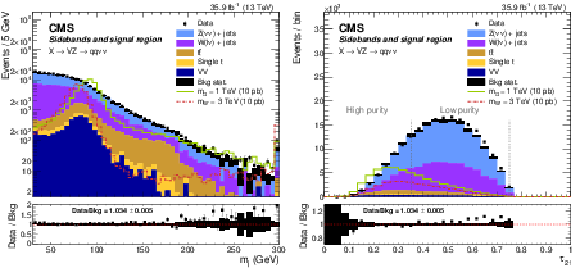
png pdf |
Figure 1:
Comparison of data and simulated events. Left: the corrected mass of the leading AK8 jet, interpreted as the hadronically decaying vector boson. Right: the distribution of the τ21 subjettiness of the vector boson candidate, which is used to define low- and high-purity categories. The background processes predicted by the SM are depicted as colored filled histograms. The shaded area on top of the histograms represents the statistical uncertainty associated to MC simulations. Overflows are shown in the rightmost bin. Two possible signal hypotheses are shown: a spin-1 W' boson with a mass of 3 TeV and a spin-2 bulk graviton with a mass of 1 TeV. The data points are shown by the black markers, along with their associated statistical uncertainties. In the bottom panels, the ratio between data and MC predictions is calculated for each bin. |
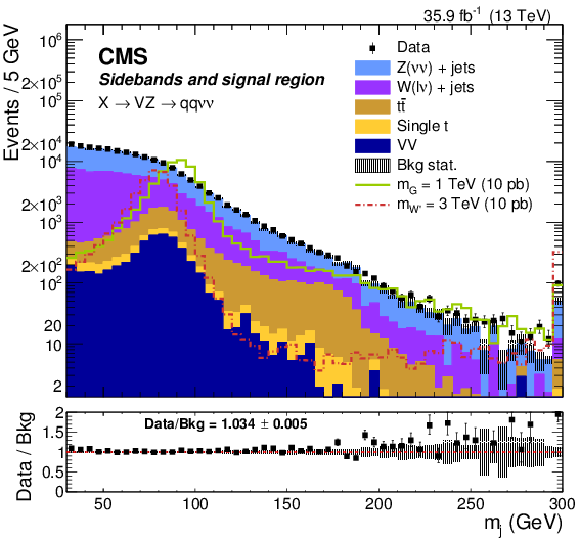
png pdf |
Figure 1-a:
Comparison of data and simulated events: the corrected mass of the leading AK8 jet, interpreted as the hadronically decaying vector boson. The background processes predicted by the SM are depicted as colored filled histograms. The shaded area on top of the histograms represents the statistical uncertainty associated to MC simulations. Overflows are shown in the rightmost bin. Two possible signal hypotheses are shown: a spin-1 W' boson with a mass of 3 TeV and a spin-2 bulk graviton with a mass of 1 TeV. The data points are shown by the black markers, along with their associated statistical uncertainties. In the bottom panel, the ratio between data and MC predictions is calculated for each bin. |

png pdf |
Figure 1-b:
Comparison of data and simulated events: the distribution of the τ21 subjettiness of the vector boson candidate, which is used to define low- and high-purity categories. The background processes predicted by the SM are depicted as colored filled histograms. The shaded area on top of the histograms represents the statistical uncertainty associated to MC simulations. Overflows are shown in the rightmost bin. Two possible signal hypotheses are shown: a spin-1 W' boson with a mass of 3 TeV and a spin-2 bulk graviton with a mass of 1 TeV. The data points are shown by the black markers, along with their associated statistical uncertainties. In the bottom panel, the ratio between data and MC predictions is calculated for each bin. |
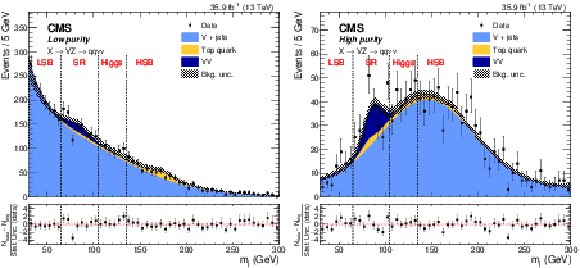
png pdf |
Figure 2:
Background yield prediction in the signal region obtained with the α method, in the low-purity (left) and high-purity (right) categories. Background processes predicted by the SM are depicted as colored areas bounded by smooth functions. The bottom panels show fit residuals normalized to their uncertainties. |
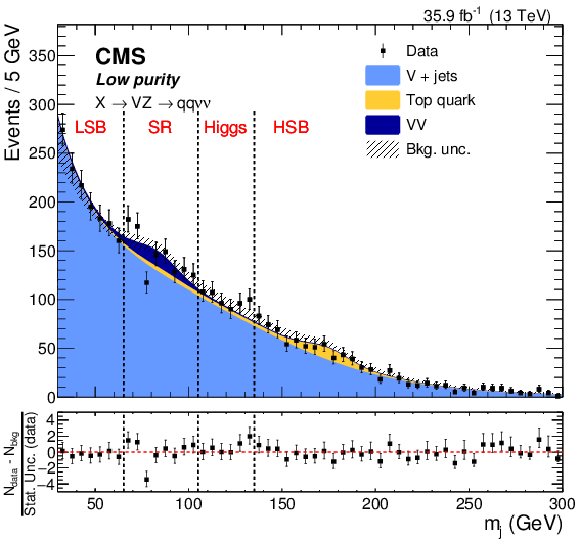
png pdf |
Figure 2-a:
Background yield prediction in the signal region obtained with the α method, in the low-purity category. Background processes predicted by the SM are depicted as colored areas bounded by smooth functions. The bottom panel shows fit residuals normalized to their uncertainties. |

png pdf |
Figure 2-b:
Background yield prediction in the signal region obtained with the α method, in the high-purity category. Background processes predicted by the SM are depicted as colored areas bounded by smooth functions. The bottom panel shows fit residuals normalized to their uncertainties. |
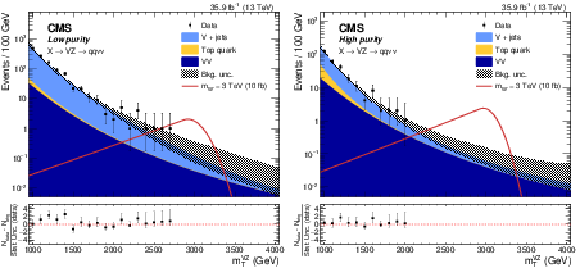
png pdf |
Figure 3:
Expected background shapes as a function of the transverse mass of the diboson candidate obtained using the α method in the low-purity (left) and high-purity (right) categories, represented as colored areas bounded by smooth functions. As a reference, the expected distribution of a W' with a mass of 3 TeV decaying into a W boson and a Z boson is displayed. Data are shown as black markers. |
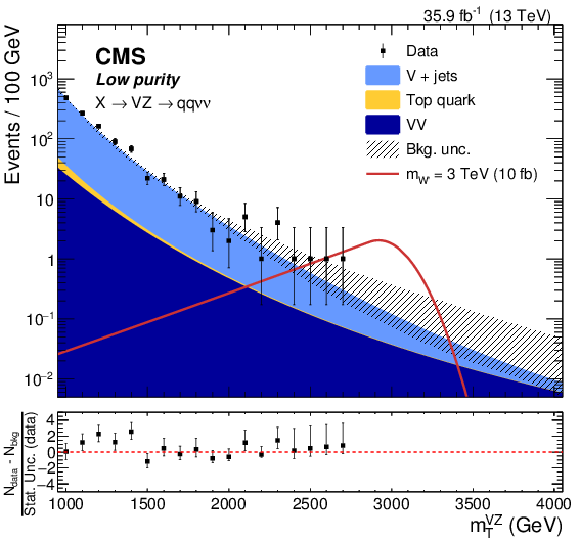
png pdf |
Figure 3-a:
Expected background shapes as a function of the transverse mass of the diboson candidate obtained using the α method in the low-purity category, represented as colored areas bounded by smooth functions. As a reference, the expected distribution of a W' with a mass of 3 TeV decaying into a W boson and a Z boson is displayed. Data are shown as black markers. |
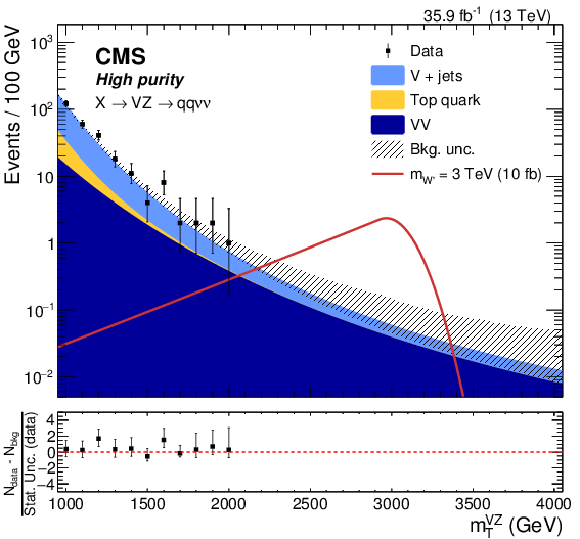
png pdf |
Figure 3-b:
Expected background shapes as a function of the transverse mass of the diboson candidate obtained using the α method in the high-purity category, represented as colored areas bounded by smooth functions. As a reference, the expected distribution of a W' with a mass of 3 TeV decaying into a W boson and a Z boson is displayed. Data are shown as black markers. |
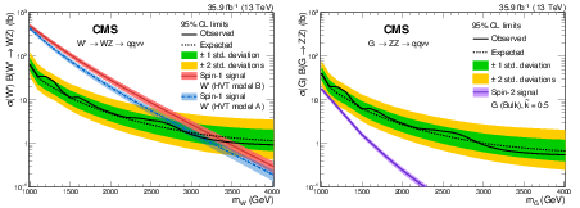
png pdf |
Figure 4:
The observed and expected limits on the product of the cross section and branching fraction σB(W′→WhadZinv) for a spin-1 HVT signal hypothesis (left) and σB(G→ZhadZinv) for a spin-2 bulk graviton signal hypothesis (right), as a function of the mass of the diboson resonance. The low- and high-purity categories have been combined. The inner and outer shaded bands indicate the 68% and 95% uncertainty intervals associated with the expected limits. Theoretical predictions are shown for: (left) the two HVT models considered, model A (blue dotted-and-dashed line) and model B (red solid line), and (right) a graviton model with a curvature parameter of ˜k= 0.5 (violet solid line). |

png pdf |
Figure 4-a:
The observed and expected limits on the product of the cross section and branching fraction σB(W′→WhadZinv) for a spin-1 HVT signal hypothesis, as a function of the mass of the diboson resonance. The low- and high-purity categories have been combined. The inner and outer shaded bands indicate the 68% and 95% uncertainty intervals associated with the expected limits. Theoretical predictions are shown for: (left) the two HVT models considered, model A (blue dotted-and-dashed line) and model B (red solid line), and (right) a graviton model with a curvature parameter of ˜k= 0.5 (violet solid line). |
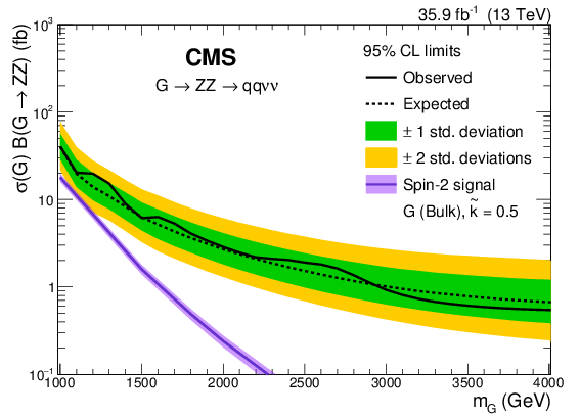
png pdf |
Figure 4-b:
The observed and expected limits on the product of the cross section and branching fraction σB(G→ZhadZinv) for a spin-2 bulk graviton signal hypothesis, as a function of the mass of the diboson resonance. The low- and high-purity categories have been combined. The inner and outer shaded bands indicate the 68% and 95% uncertainty intervals associated with the expected limits. Theoretical predictions are shown for: (left) the two HVT models considered, model A (blue dotted-and-dashed line) and model B (red solid line), and (right) a graviton model with a curvature parameter of ˜k= 0.5 (violet solid line). |
| Summary |
| A search has been made for heavy diboson resonances (WZ, ZZ) decaying into a pair of vector bosons, one of which is a Z boson decaying into ν¯ν and the other is a W or Z boson that decays into qˉq. The data were collected by the CMS detector from proton-proton collisions produced at the LHC at a center-of-mass energy of 13 TeV. In this analysis, the hadronically decaying W or Z boson is reconstructed as a large-cone jet. The invisible decay of the Z boson manifests itself as a large amount of missing transverse momentum recoiling against the jet. The transverse components of the VZ system momentum are used to define the transverse mass variable, where a search for a localized excess is performed. The expected background is described with a hybrid data/simulation approach that takes advantage of data sidebands to predict the background normalization and shape in the signal region. To improve the discovery potential, two purity categories are defined, based on jet substructure observables. An unbinned maximum likelihood fit is performed. No excess is observed in data compared to standard model predictions. Upper limits are established at 95% confidence level on the product of the production cross section and branching fraction for a spin-1 heavy vector triplet (HVT) W' boson and spin-2 bulk graviton, which are in the range 0.9-63 fb and 0.5-40 fb, respectively, depending on the resonance mass. The existence of a W' boson is excluded at 95% confidence level up to a mass of 3.1 TeV in HVT model A and up to 3.4 TeV in HVT model B. |
| References | ||||
| 1 | K. Agashe, H. Davoudiasl, G. Perez, and A. Soni | Warped gravitons at the LHC and beyond | PRD 76 (2007) 036006 | hep-ph/0701186 |
| 2 | A. L. Fitzpatrick, J. Kaplan, L. Randall, and L.-T. Wang | Searching for the Kaluza-Klein graviton in bulk RS models | JHEP 09 (2007) 013 | hep-ph/0701150 |
| 3 | L. Randall and R. Sundrum | A large mass hierarchy from a small extra dimension | PRL 83 (1999) 3370 | hep-ph/9905221 |
| 4 | L. Randall and R. Sundrum | An alternative to compactification | PRL 83 (1999) 4690 | hep-th/9906064 |
| 5 | O. Antipin, D. Atwood, and A. Soni | Search for RS gravitons via WLWL decays | PLB 666 (2008) 155 | 0711.3175 |
| 6 | D. Pappadopulo, A. Thamm, R. Torre, and A. Wulzer | Heavy vector triplets: bridging theory and data | JHEP 09 (2014) 060 | 1402.4431 |
| 7 | V. D. Barger, W.-Y. Keung, and E. Ma | A gauge model with light W and Z bosons | PRD 22 (1980) 727 | |
| 8 | C. Grojean, E. Salvioni, and R. Torre | A weakly constrained W' at the early LHC | JHEP 07 (2011) 002 | 1103.2761 |
| 9 | R. Contino, D. Marzocca, D. Pappadopulo, and R. Rattazzi | On the effect of resonances in composite Higgs phenomenology | JHEP 10 (2011) 081 | 1109.1570 |
| 10 | B. Bellazzini, C. Cs\'aki, and J. Serra | Composite Higgses | EPJC 74 (2014) 2766 | 1401.2457 |
| 11 | CMS Collaboration | Search for massive resonances decaying into WW, WZ, ZZ, qW, and qZ with dijet final states at √s= 13 TeV | Submitted to \it PRD | CMS-B2G-17-001 1708.05379 |
| 12 | CMS Collaboration | Search for heavy resonances that decay into a vector boson and a Higgs boson in hadronic final states at √s= 13 TeV | EPJC 77 (2017) 636 | CMS-B2G-17-002 1707.01303 |
| 13 | ATLAS Collaboration | Search for heavy resonances decaying to a W or Z boson and a Higgs boson in the qˉq(′)bˉb final state in pp collisions at √s= 13 TeV with the ATLAS detector | PLB 774 (2017) 494 | 1707.06958 |
| 14 | CMS Collaboration | Search for heavy resonances decaying into a vector boson and a Higgs boson in final states with charged leptons, neutrinos, and b quarks | PLB 768 (2017) 137 | CMS-B2G-16-003 1610.08066 |
| 15 | CMS Collaboration | Search for a heavy resonance decaying to a pair of vector bosons in the lepton plus merged jet final state at √s= 13 TeV | Submitted to \it JHEP | CMS-B2G-16-029 1802.09407 |
| 16 | J. Thaler and K. Van Tilburg | Identifying boosted objects with N-subjettiness | JHEP 03 (2011) 015 | 1011.2268 |
| 17 | CMS Collaboration | The CMS trigger system | JINST 12 (2017) P01020 | CMS-TRG-12-001 1609.02366 |
| 18 | CMS Collaboration | The CMS experiment at the CERN LHC | JINST 3 (2008) S08004 | CMS-00-001 |
| 19 | J. Alwall et al. | The automated computation of tree-level and next-to-leading order differential cross sections, and their matching to parton shower simulations | JHEP 07 (2014) 079 | 1405.0301 |
| 20 | R. Frederix and S. Frixione | Merging meets matching in MC@NLO | JHEP 12 (2012) 061 | 1209.6215 |
| 21 | S. Kallweit et al. | NLO QCD+EW automation and precise predictions for V+multijet production | in Proceedings, 50th Recontres de Moriond, QCD and high energy interactions, p. 121 2015 | 1505.05704 |
| 22 | P. Nason | A new method for combining NLO QCD with shower Monte Carlo algorithms | JHEP 11 (2004) 040 | hep-ph/0409146 |
| 23 | S. Frixione, P. Nason, and C. Oleari | Matching NLO QCD computations with parton shower simulations: the POWHEG method | JHEP 11 (2007) 070 | 0709.2092 |
| 24 | S. Alioli, P. Nason, C. Oleari, and E. Re | A general framework for implementing NLO calculations in shower Monte Carlo programs: the POWHEG BOX | JHEP 06 (2010) 043 | 1002.2581 |
| 25 | J. M. Campbell, R. K. Ellis, P. Nason, and E. Re | Top-pair production and decay at NLO matched with parton showers | JHEP 04 (2015) 114 | 1412.1828 |
| 26 | E. Re | Single-top Wt-channel production matched with parton showers using the POWHEG method | EPJC 71 (2011) 1547 | 1009.2450 |
| 27 | T. Sjostrand, S. Mrenna, and P. Z. Skands | A brief introduction to PYTHIA 8.1 | CPC 178 (2008) 852 | 0710.3820 |
| 28 | CMS Collaboration | Event generator tunes obtained from underlying event and multiparton scattering measurements | EPJC 76 (2016) 155 | CMS-GEN-14-001 1512.00815 |
| 29 | NNPDF Collaboration | Parton distributions from high-precision collider data | EPJC 77 (2017) 663 | 1706.00428 |
| 30 | GEANT4 Collaboration | GEANT4---a simulation toolkit | NIMA 506 (2003) 250 | |
| 31 | CMS Collaboration | Particle-flow reconstruction and global event description with the CMS detector | JINST 12 (2017) P10003 | CMS-PRF-14-001 1706.04965 |
| 32 | M. Cacciari, G. P. Salam, and G. Soyez | FastJet user manual | EPJC 72 (2012) 1896 | 1111.6097 |
| 33 | M. Cacciari, G. P. Salam, and G. Soyez | The anti-kt jet clustering algorithm | JHEP 04 (2008) 063 | 0802.1189 |
| 34 | CMS Collaboration | Determination of jet energy calibration and transverse momentum resolution in CMS | JINST 6 (2011) P11002 | CMS-JME-10-011 1107.4277 |
| 35 | CMS Collaboration | Pileup removal algorithms | CMS-PAS-JME-14-001 | CMS-PAS-JME-14-001 |
| 36 | CMS Collaboration | Jet energy scale and resolution in the CMS experiment in pp collisions at 8 TeV | JINST 12 (2017) P02014 | CMS-JME-13-004 1607.03663 |
| 37 | M. Dasgupta, A. Fregoso, S. Marzani, and G. P. Salam | Towards an understanding of jet substructure | JHEP 09 (2013) 029 | 1307.0007 |
| 38 | A. J. Larkoski, S. Marzani, G. Soyez, and J. Thaler | Soft drop | JHEP 05 (2014) 146 | 1402.2657 |
| 39 | D. Bertolini, P. Harris, M. Low, and N. Tran | Pileup per particle identification | JHEP 10 (2014) 059 | 1407.6013 |
| 40 | Y. L. Dokshitzer, G. D. Leder, S. Moretti, and B. R. Webber | Better jet clustering algorithms | JHEP 08 (1997) 001 | hep-ph/9707323 |
| 41 | M. Wobisch and T. Wengler | Hadronization corrections to jet cross-sections in deep inelastic scattering | in Proceedings of the Workshop on Monte Carlo Generators for HERA Physics, Hamburg, Germany, p. 270 1998 | hep-ph/9907280 |
| 42 | CMS Collaboration | Identification techniques for highly boosted W bosons that decay into hadrons | JHEP 12 (2014) 017 | CMS-JME-13-006 1410.4227 |
| 43 | CMS Collaboration | Performance of missing energy reconstruction in 13 TeV pp collision data using the CMS detector | CMS-PAS-JME-16-004 | CMS-PAS-JME-16-004 |
| 44 | CMS Collaboration | Identification of b-quark jets with the CMS experiment | JINST 8 (2013) P04013 | CMS-BTV-12-001 1211.4462 |
| 45 | CMS Collaboration | Identification of heavy-flavour jets with the CMS detector in pp collisions at 13 TeV | Submitted to \it JINST | CMS-BTV-16-002 1712.07158 |
| 46 | CMS Collaboration | Search for a Higgs boson in the mass range from 145 to 1000 GeV decaying to a pair of W or Z bosons | JHEP 10 (2015) 144 | CMS-HIG-13-031 1504.00936 |
| 47 | M. Bahr et al. | Herwig++ physics and manual | EPJC 58 (2008) 639 | 0803.0883 |
| 48 | CMS Collaboration | CMS luminosity measurements for the 2016 data taking period | CMS-PAS-LUM-17-001 | CMS-PAS-LUM-17-001 |
| 49 | J. Butterworth et al. | PDF4LHC recommendations for LHC Run II | JPG 43 (2016) 023001 | 1510.03865 |
| 50 | CMS Collaboration | Measurement of the ZZ production cross section and Z →ℓ+ℓ−ℓ′+ℓ′− branching fraction in pp collisions at √s= 13 TeV | PLB 763 (2016) 280 | CMS-SMP-16-001 1607.08834 |
| 51 | CMS Collaboration | Measurement of the WZ production cross section in pp collisions at √s= 13 TeV | PLB 766 (2017) 268 | CMS-SMP-16-002 1607.06943 |
| 52 | CMS Collaboration | Cross section measurement of t-channel single top quark production in pp collisions at √s= 13 TeV | PLB 772 (2017) 752 | CMS-TOP-16-003 1610.00678 |
| 53 | CMS Collaboration | Measurement of the tˉt production cross section using events in the eμ final state in pp collisions at √s= 13 TeV | EPJC 77 (2017) 172 | CMS-TOP-16-005 1611.04040 |
| 54 | CMS Collaboration | Measurement of the tˉt production cross section using events with one lepton and at least one jet in pp collisions at √s= 13 TeV | JHEP 09 (2017) 051 | CMS-TOP-16-006 1701.06228 |
| 55 | M. J. Oreglia | A study of the reactions ψ′→γγψ | PhD thesis, Stanford University, 1980 SLAC Report SLAC-R-236, see Appendix D | |
| 56 | A. L. Read | Presentation of search results: The CLs technique | JPG 28 (2002) 2693 | |
| 57 | T. Junk | Confidence level computation for combining searches with small statistics | NIMA 434 (1999) 435 | hep-ex/9902006 |
| 58 | G. Cowan, K. Cranmer, E. Gross, and O. Vitells | Asymptotic formulae for likelihood-based tests of new physics | EPJC 71 (2011) 1554 | 1007.1727 |
| 59 | ATLAS Collaboration | Searches for heavy ZZ and ZW resonances in the ℓℓqq and ννqq final states in pp collisions at √s= 13 TeV with the ATLAS detector | Submitted to \it JHEP | 1708.09638 |

|
Compact Muon Solenoid LHC, CERN |

|

|

|

|

|

|